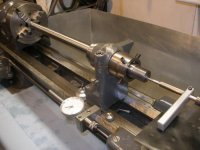What's the real advantage of having and using a set tru chuck compared to a quality scroll chuck. I'm looking to buy a nice chuck for my lathe and I'm just not sure what chuck to purchase. I have my eyes on a bison 4 jaw that works independently or as a scroll. I know nothing about them other than the idea sounds good.
I have a bison 3 jaw in the shop I picked up for next to nothing but I need a back plate and the numbers on the front of this chuck "1112" don't match any catalog model number, so I really don't know what I have. Nor do I know what back plate to buy. I may end up making one from a d1-6 blank. Then there is the question of how accurate this chuck is. This chuck may not be any more accurate than the cheap import that came with my machine?
I'm going to start chambering my barrels with a 4 post steady rest once it's built, so I need a good chuck that I can use to dial my muzzle end in with. I though about making a spider that I can hold in a 3 jaw since I already this bison here. I wouldn't have to buy anything other than the back plate blank. Just not sure what will be best yet.
I like the idea of having a good quality chuck that I can use for most everything. I hate changing my chucks. There heavy and these cheap import chucks I have don't fit my spindle taper very well. They are really difficult to get back on so they are true. Not sure why but either my spindle is a tad bit big, or the chucks are off. I have to use a dead blow to snug these chucks up so they are true. Pain in the butt! Anyway any thoughts on what chucks I could use, and is a set tru worth the extra money. Chucks aren't cheap, that's one thing I have realized in my search. Lol! Thanks lee
I have a bison 3 jaw in the shop I picked up for next to nothing but I need a back plate and the numbers on the front of this chuck "1112" don't match any catalog model number, so I really don't know what I have. Nor do I know what back plate to buy. I may end up making one from a d1-6 blank. Then there is the question of how accurate this chuck is. This chuck may not be any more accurate than the cheap import that came with my machine?
I'm going to start chambering my barrels with a 4 post steady rest once it's built, so I need a good chuck that I can use to dial my muzzle end in with. I though about making a spider that I can hold in a 3 jaw since I already this bison here. I wouldn't have to buy anything other than the back plate blank. Just not sure what will be best yet.
I like the idea of having a good quality chuck that I can use for most everything. I hate changing my chucks. There heavy and these cheap import chucks I have don't fit my spindle taper very well. They are really difficult to get back on so they are true. Not sure why but either my spindle is a tad bit big, or the chucks are off. I have to use a dead blow to snug these chucks up so they are true. Pain in the butt! Anyway any thoughts on what chucks I could use, and is a set tru worth the extra money. Chucks aren't cheap, that's one thing I have realized in my search. Lol! Thanks lee




![13[1].JPG 13[1].JPG](https://benchrest.com/forum/data/attachments/6/6736-70a4dbb0651c080c6cbb48630e14ee03.jpg)